The Gift of South Dakota
Subscriptions to South Dakota Magazine make great gifts!
Subscribe today — 1 year (6 issues) is just $29!
In Search of the Fairburn Agate
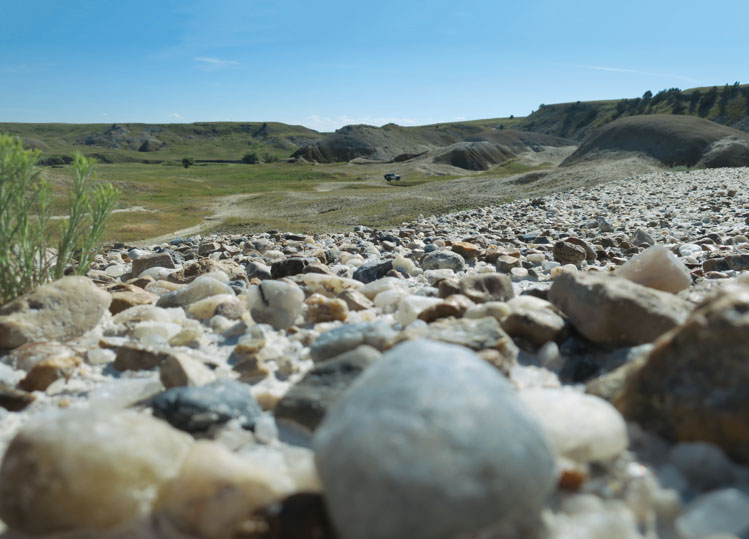 |
| Fairburn agates can be found in several locations in southwestern South Dakota, but the most popular spot might be the Kern agate beds east of Fairburn. |
It was barely past 9 a.m. and sweat already soaked our shirts. The forecast called for highs in the 90s, but as the sun baked the hardened gumbo and reflected off rocks strewn throughout the Kern agate beds east of Fairburn we could feel the midday heat about six hours early.
We had met Don Bahr, a retired law enforcement officer and rock hound, in Rapid City at 7:30 that morning and headed south toward Fairburn in search of Fairburn agates, perhaps the most sought after gemstone in South Dakota. “I can’t guarantee anything,” Bahr had cautioned us several times in the preceding months as we planned our trip, knowing that people have spent days scraping and turning rocks only to leave with nothing. We told him that we understood; we didn’t really expect to find anything. We just wanted an inside look at this rare and valuable gem that beckons to rock hounds far and wide, who venture far off the beaten path hoping to find a Fairburn — or even a piece of a Fairburn — even though at the end of the day all they have are a backache and a sweat-soaked shirt.
***
Fairburn Agates hold a curious power over collectors who scour the Black Hills and Badlands for them. Various types of agates — colorful gemstones formed millions of years ago inside sedimentary rock — are found all around the world. The Lake Superior Agate, found along the shores of its namesake lake, is highly prized in Minnesota, Wisconsin and Michigan. Even in western South Dakota, rock hounds discover water agates, lace agates, bubble gum agates, prairie agates and several other varieties that feature interesting shapes and patterns inside. But the Fairburn remains elusive and highly prized. It is only found in the Black Hills and surrounding badlands and grasslands of southwest South Dakota and northwest Nebraska. Its outer shell — often a chocolate or sandy brown coating called the matrix — is not necessarily impressive, but its bright, concentric inner rings of red, orange, yellow, pink, blue, green or even black and incredibly tight banding can be mesmerizing. They are unlike any other gem on earth; collectors pay hundreds of dollars (and sometimes more than $1,000) for particularly good specimens.
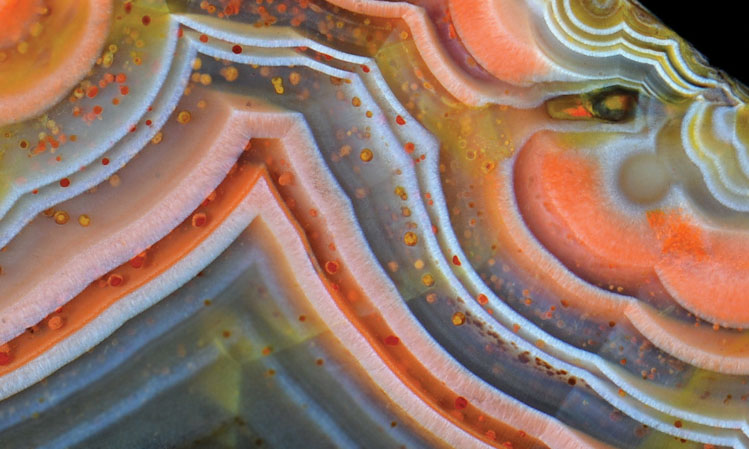 |
| Fairburn agates, the official state gemstone of South Dakota, are recognizable by their bright colors and tight banding. Photo by Thomas P. Shearer. |
Roger Clark was already a rock hound, but on a trip to the Badlands in the early 1970s he bought a book called Midwest Gem Trails by June Culp Zeitner, one of South Dakota’s pre-eminent amateur geologists and rock hounds. That’s how Clark, a lawyer practicing in Appleton, Wisconsin, discovered Fairburn agates. He knew immediately that he had to find one.
“It was kind of like a small, obsessive compulsive disorder,” he says with a chuckle. “And the longer it went on, the more the obsession grew.”
Three to five times a year, Clark made time for hunting trips to South Dakota. “I was so obsessed that I would leave work on Wednesday afternoon and drive to Sioux Falls. I’d get up in the morning and I could be out in the Badlands that afternoon. I could hunt for two days, and then I’d drive 14 hours back and go to work on Monday. It’s ridiculous to talk about it now, but you just get obsessed with these things.”
He searched for two years and never found a Fairburn. Then he met Art and Ann Bruce, veteran rock hunters from Hot Springs who were nearly 80 but still quite active. The Bruces agreed to take Clark and his wife, Mary Jane, to the agate beds and teach them. One day, on a trip to the Nebraska grasslands just south of Ardmore, Clark found his first Fairburn. “It was just happenstance,” he says. “I just happened to turn over the right rock.”
Today, Clark has around 1,000 Fairburn agates in his collection, and he’s bought and sold many more. But his first agate remains on a shelf in his home office. “It’s red, and then clear, and then pink. Those are the predominant colors. It’s not a spectacular agate, but it’s just one of those moments that you remember.”
***
Not much was known about Fairburn agates when Clark started hunting them. In fact, it wasn’t until the 1930s and 1940s that interest in Fairburn agates began to sweep across the rock collecting community. “The longer I went on, the more I realized that I had to figure out where these things came from,” he says. “They don’t just appear in the Badlands. It didn’t make sense to me that nobody had followed that geologic course to find out where they originated.”
June Culp Zeitner was among the first to write extensively about Fairburns. Zeitner was born in Michigan in 1916, but her family eventually settled in Aberdeen. She graduated from Northern State University and took a job teaching in Mission, on the Rosebud Reservation. That’s where she met Albert Zeitner, whose family ran a hardware store and oversaw a small museum and rock shop. The two became acquainted, and for their first date Zeitner drove them to a remote location in the Badlands. He stopped the car, got out and disappeared over a hill. Soon she heard him shouting, “Fairburn! Fairburn!” She thought some sort of accident had befallen him and he was being burned, but her beau had actually found an agate. The experience not only created a memorable first date, but it launched June on a completely new trajectory and introduced her to a hobby that occupied much of her life.
The Zeitners traveled throughout North America from the 1950s through the 1980s, exploring mines and learning about the rocks and minerals they found. June wrote several books, more than 1,000 magazine articles and served as an assistant editor of Lapidary Journal, a periodical devoted to mineralogy. Perhaps her most important book, the one Clark bought on his trip to the Badlands, was Midwest Gem Trails, a field guide for rock and fossil hunters originally published in 1964.
Zeitner also created the State Stone Program, which allows each state to select an official state gem, fossil, mineral or rock. The South Dakota legislature officially designated the Fairburn agate as its state gemstone in 1966. When Zeitner died in Rapid City in 2009 at the age of 93, she was known far and wide as the First Lady of Gems.
During the decades Zeitner was writing about Fairburn agates, several theories explained their origin. Some people thought they had formed through ancient volcanic activity in the Badlands. Others proposed they had been eroded and somehow swept east when the Rocky Mountains formed.
A wrinkle in those ideas came when agates that looked almost exactly like Fairburns were discovered in Teepee Canyon, about 14 miles west of Custer and nearly 60 miles from the agate beds east of Fairburn. They appeared to be emerging from a layer of limestone, and they had the same bright patterns and banding as the Badlands agates. Zeitner suggested that maybe they were related, and even that Fairburn agates could have originated in the Black Hills. But other longtime collectors, including the Bruces of Hot Springs, refused to acknowledge any possible connection between Teepee Canyon agates and Fairburn agates.
Clark immersed himself in this world of conflicting theories. He studied Zeitner and the writings of other scholars and rock hounds and compared them with his own experience in the field. By 1998, he’d accumulated enough knowledge to present his own Fairburn agate origin story in a book called South Dakota’s Fairburn Agate, which includes diagrams and beautiful agate photography by his wife, Mary Jane. It is still available in certain museums and rock shops in the Hills.
His idea coincides with those of several other Black Hills geologists, and has come to be widely accepted. Fairburn agates were created between 250 million and 300 million years ago within the Minnelusa Formation, a layer of limestone that ranges from 75 to 1,300 feet thick and encircles the Black Hills. During the Black Hills uplift, between 35 million and 70 million years ago, around 400 square miles of the Minnelusa Formation was eroded — along with the agates it contained — and swept east into the Badlands. The agates were buried and are now slowly being revealed.
Some agate hunters still drew a firm line between Teepee Canyon agates and Fairburn agates, so Clark’s book was skeptically received. But in August of 2000 the Jasper Fire burned more than 85,000 acres of the Black Hills, including Teepee Canyon. “That location had been hunted for years, but when that fire burned, it burned off 8 or 10 miles of forest north of that Teepee Canyon area,” Clark says. “It was a very hot fire and it burned right down to the dirt. Afterwards, you’d see agates everywhere peeking out at you. That’s when we were really able to nail down the origin as the Minnelusa Formation.”
Exactly how Fairburn agates form remains somewhat mysterious. During the age in which they were created, far western South Dakota lay at the bottom of a vast ocean. Some geologists say that water rich in silica slowly trickled through passageways in the rock, and over time silica accumulated inside tiny pockets, creating an agate. Other compounds in the water, such as iron oxide (red) and manganese oxide (black), created the various colors.
Based on research conducted since the first printing of his book, Clark now believes that agates formed through a replacement process. Those pockets were originally filled with calcite, which dissolved when silica came into contact with it. And there is still debate over what causes the tight banding. “There are things that we still don’t understand,” Clark says. “It’s still a mysterious process. I’m 77 now, and I don’t think I’ll know in my lifetime, but that’s okay.”
***
“It’s like walking on the moon out here,” Bahr said as his gray 4x4 Jeep slowly navigated the heavily rutted path leading to the Kern agate beds.
The beds lie about 14 miles east of Fairburn, a tiny town of fewer than 100 people in Custer County that was settled in 1879. Its name — “Fair,” for pleasant and “burn,” the Scottish term for a stream or brook — is a nod to the winding French Creek, which flows just south of town.
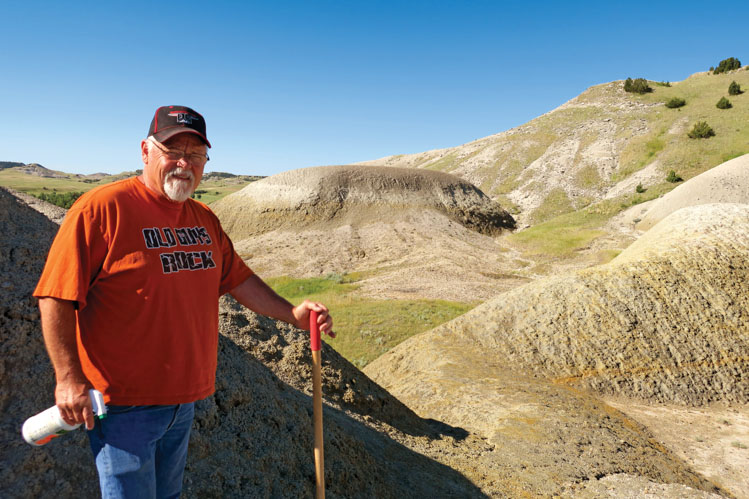 |
| Armed with a three-tined garden rake and a spray bottle of water, Don Bahr searches for elusive Fairburn agates. |
We followed French Creek Road, a well maintained gravel route that passes several large ranches. As we turned north just beyond an old 4-H campground, the terrain grew rough. Bahr’s Jeep shook and rattled as we crossed the bone-dry bed of French Creek (“You do see a muffler lying on the ground out here once in a while,” he joked) and began the slight ascent into a landscape that did indeed look otherworldly.
Rocky hills rolled as far as the eye could see, covering thousands of acres. Maps often show the Fairburn agate beds as an elliptical belt stretching from near Creston in Pennington County to Orella in Sioux County, Nebraska. The beds vary in width, but the widest expanse covers about 15 miles near Red Shirt.
As we drove into the hills, we passed vehicles bearing license plates from Wyoming, Minnesota and New York — proof that hunters from near and far are welcome to scour the beds as long as they have the means to get there. That was not always the case.
An old widow that most agate hunters today know only as Grandma Kern may have been among the first people to realize what treasures could be found on her ranch land. Zeitner recounted the story of Jack Zasadil of Hermosa, who went agate hunting for the first time on the Kern ranch sometime in the late 1920s or early 1930s, only to be chased off by Grandma Kern and her shotgun. But as word spread and more rock hunters began showing up at Grandma Kern’s house, she started following them around the agate beds with coins in her apron pockets, hoping to buy what they found. Her cooperation may have been hastened by her ever-worsening blindness, which meant she could no longer find for herself the agates she grew to love.
Today there is no sign that anyone ever lived in these hills. A visitor might wonder if it would even be possible.
Bahr reminded us to keep our eyes on the ground the moment we stepped out of the Jeep. Fairburn agates aren’t found just on the hillsides. They can be hidden in patches of grass or even lying along the road. It’s also important to watch for rattlesnakes that occasionally come out to sun themselves on the rocky ground.
Our tools for the day were simple: a three-tined garden fork and a spray bottle of water. As we climbed the hills, Bahr scraped his rake through the top layer of rocks. “My theory is that there are all sorts of agates, just beneath the surface, or just barely poking out,” he says. “It’s just a stroke of luck to find one, because they’re not always just lying on the surface.”
Bahr has been a recreational rock hunter for 14 years. His first trip to the Kern beds offered a lesson in perseverance. “When you’re out here, you find these agates that look like Fairburns, but they’re prairie or water agates,” he says. “That first day I thought I was loaded. My pockets were bulging. But I didn’t have a single Fairburn.”
It took some time to learn the telltale attributes of a Fairburn. Now, as we scraped, kicked and dug our way up and down the hills, turning as many rocks as we could, hoping to see the bright colors and banding, Bahr simply said, “If you have to ask if it’s a Fairburn, it’s not.”
Still, we were unsure. Bahr had told us what to look for in the matrix — that brownish-gray outer shell — but the rocks began to look alike. “You could spend a week out here and not find a thing,” he gently reminded us.
He was in the middle of explaining the differences between volcanic and sedimentary agates when suddenly he stopped mid-sentence. “There’s Fairburn right there!” he said, hardly able to disguise his disbelief.
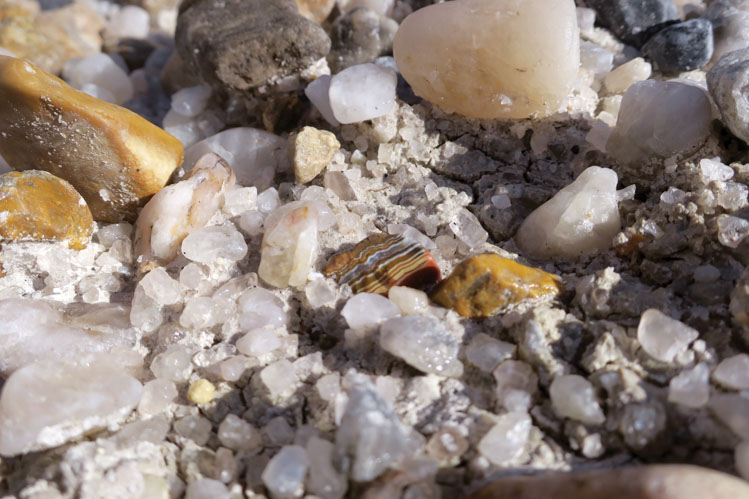 |
| Our Fairburn agate, as we discovered it. |
Could it be, that after no more than 20 minutes of searching, we had found what eludes other hunters for days, weeks, months and longer? We crouched to get a closer look, and though we’d never seen a Fairburn agate in person we recognized it immediately. Lying among white quartz, rose quartz, petrified wood and a multitude of other rocks was a tiny stone with blue, brown, yellow and red layers. A few sprays of water accentuated the colors and made the banding appear even more pronounced. It was less than an inch long — most likely a fragment from a much larger agate — but there was no mistaking that it was a Fairburn.
“There could be more right around here,” Bahr said, “but there are stories of people finding a piece like this, and somebody else finds one a mile away, and they fit together.”
We’ll probably never know where the rest of our agate lies. We searched the hills for another 90 minutes but found nothing more.
Do we attribute our discovery to beginner’s luck? Perhaps, but maybe we owed Mother Nature a debt of gratitude, as well. The night before our visit, the area around Fairburn received about an inch of rain, which helped wash away the top layer of rocks, exposing new stones that are slowly but constantly rising to the surface.
When Roger Clark began hunting agates more than 40 years ago, old timers like Art Bruce told him there was no point in visiting the Kern beds. “He was very clear that the agates had all been picked up,” Clark recalls. “They were gone. There was no use looking out in the Badlands anymore. People had just kind of given up. Now we know that it’s just a matter of time. Agates are washing out all the time in the Badlands.”
***
Fairburn agate hunting continues to evolve. Hunters still frequent the Kern beds and other hot spots in the Black Hills and Badlands, but today agates can just as easily be found in the middle of Rapid City. Landscape rock and other fill material often comes from gravel pits along the Cheyenne River. The pits are typically on private land and collectors need permission before exploring them, but the large piles of fresh material have often yielded beautiful agates. We heard of Fairburns being found in the parking lots at Walmart, K-Mart and even the roof of the Custer County jail.
Trade shows are still popular gathering places for rock hounds, but there is also a busy Facebook page called Fairburn Agate Hunter, where more than 2,200 people share their finds and stories.
It’s a passion that not everyone shares, but for those who do, the sweat, dirt and pain are all worth it. “In order to find a Fairburn, you may have to slide onto a cactus as I did,” June Culp Zeitner once wrote. “You may wear holes in your jeans rubbing the dust off stones to look for signs of fortifications. You may stare holes through your glasses. You may let out a yelp at a discarded rattlesnake skin, and get lost in a ravine.
“There’s something about it all that makes a real rockhound consider this fun. He wouldn’t work as hard for anyone for even the best wages, but to do it for fun — that’s different.”
Our hot day in the agate beds was just as she described. The working conditions might not sound good on a job advertisement — heat, isolation, random success and rattlesnakes — but the search gets in your blood.
Editor’s Note: This story is revised from the May/June 2018 issue of South Dakota Magazine. To order a copy or to subscribe, call (800) 456-5117.


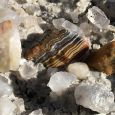
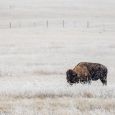
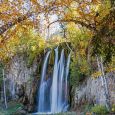


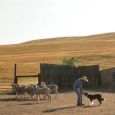


Comments